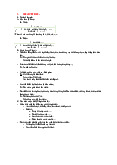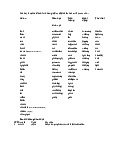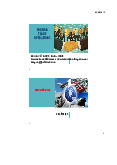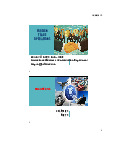














Preview text:
5.5 IELTS COURSE LISTENING – LESSON 3 Nội dung bài học
Giới thiệu dạng bài trắc nghiệm.....................................................................................................................1
Chiến lược xử lý dạng bài trắc nghiệm..........................................................................................................3
Ví dụ minh họa................................................................................................................................................4
Luyện tập.........................................................................................................................................................8
Từ vựng.........................................................................................................................................................12
Sơ đồ tổng kết.............................................................................................................................................. 15
Giới thiệu dạng bài trắc nghiệm -
Dạng bài trắc nghiệm trong bài thi Nghe IELTS có 2 hình thức:
Thí sinh được yêu cầu chọn 1 đáp án
Thí sinh được yêu cầu chọn nhiều đáp án
Ví dụ: Customer wants goods delivered to
Ví dụ: What TWO disadvantages of the new A port
mobile phone does the speaker mention? B home
A it isn’t very user-friendly C office B it is very expensive C it can’t take photographs D it has a short battery life E it is quite big -
Thứ tự thông tin trong bài nghe được sắp xếp giống với trình tự các câu hỏi. -
Bài nghe sẽ chứa thông tin về tất cả các phương án nhưng được sắp xếp lộn xộn lộn xộn và có
nhiều chi tiết gây nhiễu. -
Các kỹ năng cần thiết để xử lý dạng bài trắc nghiệm: o
Nhận diện được yếu tố gây nhiễu. Yếu tố gây nhiễu là các phương án được đề cập
trong bài nghe nhưng không phải đáp án. o
Nhận diện được thông tin được paraphrase (cách diễn đạt khác nhau của các từ khóa
trong câu hỏi hoặc các lựa chọn) 1
Xác định các yếu tố gây nhiễu trong các câu sau và điền từ vào chỗ trống. Questions Distractors What date will they leave? 1
…………………………………………….
What day will the tour visit the farm? 2
……………………………
The students decide to do a project about 3
……………………………………………. Problems: 4 ● poor weather ●
a lack of ……………………………………
(The Official Cambridge Guide to IELTS)
Nhận diện các thông tin được thay thế và chọn đáp án cho các câu hỏi sau. synonyms/paraphrase reasons why other options are incorrect 1
What do they decide to organize first? A. a place to stay B. their airfares C. car hire 2
What change will they make in the garden? A. improve the shade B. remove plants C. add a water feature 3
What do the students agree they need to do their project? A. do more research B. make some cuts C. add some visual effects 4 The scientists are studying A. how snow forms in different conditions B. the effect that snow has on our climate C. the effect different clouds have on snow
(The Official Cambridge Guide to IELTS) 2
Chiến lược xử lý dạng bài trắc nghiệm Trước khi nghe ●
Xác định số đáp án phải chọn ●
Đọc lướt để hiểu nhanh ý chính các câu hỏi và các phương án cho từng câu và gạch chân từ
khóa của từng câu. Về các từ khóa, lưu ý: o
Từ khóa trong câu hỏi: dùng để định vị vùng thông tin chứa đáp án
Nên ưu tiên xác định từ khóa khó thay thế (danh từ riêng, con số, thuật ngữ) o
Từ khóa trong phương án: dùng để nghe hiểu, lọc đáp án và thông tin gây nhiễu
Nên dự đoán các từ đồng nghĩa/cách diễn đạt khác của từ khóa Trong khi nghe ●
Xác định vùng thông tin chứa đáp án dựa vào từ khóa trong câu hỏi đã được xác định trước đó ●
Xác định yếu tố gây nhiễu/lý do khiến phương án sai ●
Xác định các thông tin được paraphrase để tìm ra đáp án ●
Đối với các câu chưa nghe ra đáp án, có thể ghi chú lại các thông tin nghe được để đối chiếu sau Sau khi nghe ●
Kiểm tra lại các đáp án đã chọn ●
Kiểm tra phần ghi chú đối với các câu chưa nghe được để đưa ra đáp án phù hợp nhất 3 Ví dụ minh họa
a. Dạng một đáp án
1. How can you move around the park?
A. by tram, walking or bicycle
B. by solar car or bicycle
C. by bicycle, walking or bus
2. The rare breed animals kept in the park include A. hens and horses. B. goats and cows. C. goats and hens
3. What is the main purpose of having the Rare Breeds Section?
A. to save unusual animals
B. to keep a variety of breeds
C. to educate the public Trước khi nghe: Gạch chân từ khóa Xử lý từ khóa
1. How can you move around the park?
Dấu hiệu định vị thông tin chứa đáp án
A. by tram, walking or bicycle Dự đoán paraphrase: - walking go on foot
B. by solar car or bicycle - bicycle bike
C. by bicycle, walking or bus
2. The rare breed animals kept in the park
Dấu hiệu định vị thông tin chứa đáp án include A. hens and horses
Tên động vật, không thể paraphrase B. goats and cows. C. goats and hens
3. What is the main purpose of having the Rare
Dấu hiệu định vị thông tin chứa đáp án Breeds Section?
A. to save unusual animals Dự đoán paraphrase: - save protect / preserve - unusual rare 4
B. to keep a variety of breeds Dự đoán paraphrase: - keep maintain - a variety of a wide range of / a number of / many / various
C. to educate the public Dự đoán paraphrase: - educate raise awareness 5 Sau khi nghe ●
Kiểm tra lại các đáp án đã chọn ●
Kiểm tra phần ghi chú đối với các câu chưa nghe được để đưa ra đáp án phù hợp nhất
Ví dụ: Từ ghi chú “diversity", người nghe sẽ thấy đây là từ gần nghĩa với “a variety of” ở phương án B
có thể chọn phương án B 6
b. Dạng nhiều đáp án
Choose TWO letters, A-E
Which TWO activities on the last Digital Inclusion Day did participants describe as useful? A. learning to use tablets B. communicating with family C. shopping online D. playing online games E. sending emails Trước khi nghe Gạch chân từ khóa Xử lý từ khóa
Which TWO activities on the last Digital
Dấu hiệu định vị thông tin chứa đáp án
Inclusion Day did participants describe as Dự đoán paraphrase: useful? useful helpful, come in handy A. learning to use tablets
Dự đoán paraphrase: know how to use
B. communicating with family
Dự đoán paraphrase: talk with family / family members C. shopping online
Dự đoán paraphrase: buy things online D. playing online games
Dự đoán paraphrase: play games on computer E. sending emails
Dự đoán paraphrase: use emails Trong khi nghe
The feedback was very positive. The really encouraging thing
was that participants all said they felt much more confident
about using social media to keep in touch with their
grandchildren, who prefer this form of communication to
phoning or sending emails. A lot of them also said playing
online games would help them make new friends and keep
their brains active. They weren’t that impressed with being able
to order their groceries online, as they like going out to the
shops, but some said it would come in handy if they were ill or the weather was really bad. Sau khi nghe ●
Kiểm tra lại các đáp án đã chọn 7 Luyện tập Luyện tập 1:
Choose the correct letter, A, B or C. New city developments 11.
The idea for the two new developments in the city came from A. local people B. the City Council C. the SWRDC 12.
What is unusual about Brackenside pool?
A. its architectural style B. its heating system
C. its method of water treatment 13.
Local newspapers have raised worries about
A. the late opening date
B. the cost of the project
C. the size of the facilities 14.
What decision has not yet been made about the pool?
A. whose state will be at the door
B. the exact opening times C. who will open it (Cambridge Practice Test 10) Gợi ý: ●
Xác định số đáp án phải chọn ●
Xác định từ khóa ở câu hỏi và các phương án ●
Tập trung khi từ khóa xuất hiện trong bài nghe ●
Phát hiện thông tin gây nhiễu để loại bỏ ● 8 Luyện tập 2: Questions 21 and 22
Choose TWO letters, A-E.
Which TWO hobbies was Thor Heyerdahl very interested in as a youth? A. camping B. climbing C. collecting D. hunting E. reading Questions 23 and 24
Choose TWO letters, A-E.
Which do the speakers say are the TWO reasons why Heyerdahl went to live on an island? A. To examine ancient carvings
B. To experience an isolated place C. To formulate a new theory D. To learn survival skills
E. To study the impact of an extreme environment Questions 25-30
Choose the correct letter, A, B or C.
The later life of Thor Heyerdahl 25.
According to Victor and Olivia, academics thought that Polynesian migration from the east was impossible due to
A. the fact that Eastern countries were far away
B. the lack of materials for boat building
C. the direction of the winds and currents 26.
Which do the speakers agree was the main reason for Heyerdahl’s raft journey?
A. to overcome a research setback
B. to demonstrate a personal quality C. to test a new theory 27.
What was most important to Heyerdahl about his raft journey?
A. the fact that he was the first person to do it
B. the speed of crossing the Pacific
C. the use of authentic construction methods 28.
Why did Heyerdahl go to Easter Island?
A. to build a stone statue B. to sail a reed boat
C. to learn the local language 29.
In Olivia’s opinion, Heyerdahl’s greatest influence was on
A. theories about Polynesian origins
B. the development of archaeological methodology
C. establishing archaeology as an academic subject 9 30.
Which criticism do the speakers make of William Oliver’s textbook?
A. Its style is out of date
B. Its content is over-simplified
C. Its methodology is flawed (Cambridge Practice Test 10) Luyện tập 3: Questions 21 and 22
Choose TWO letters, A-E
Which TWO characteristics were shared by the subjects of Joanna’s psychology study?
A. They had all won prizes for their music.
B. They had all made music recordings.
C. They were all under 27 years old.
D. They had all toured internationally
E. They all played a string instrument Questions 23 and 24
Choose TWO letters, A-E.
Which TWO points does Joanna make about her use of telephone interviews?
A. It meant rich data could be collected.
B. It allowed the involvement of top performers.
C. It led to a stressful atmosphere at times.
D. It meant interview times had to be limited.
E. It caused some technical problems. Questions 25 and 26
Choose TWO letters, A-E.
Which TWO topics did Joanna originally intend to investigate in her research?
A. regulations concerning concert dress
B. audience reactions to the dress of performers
C. changes in performer attitudes to concert dress
D. how choice of dress relates to performer roles
E. links between musical instrument and dress choice 10




